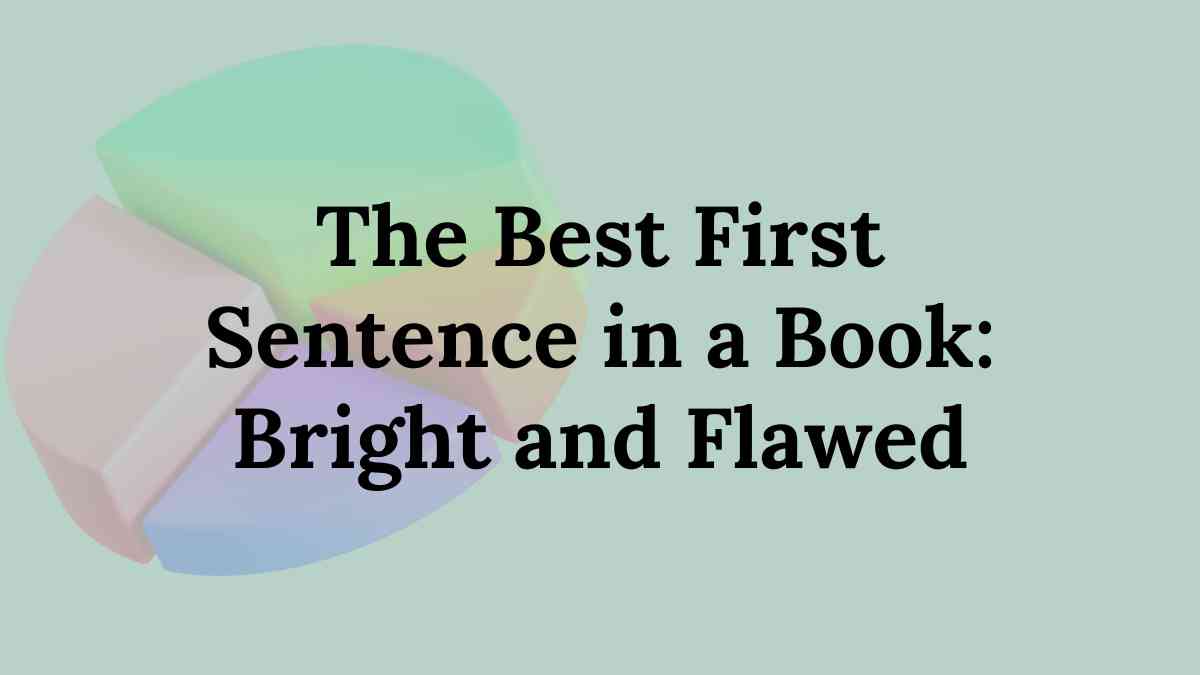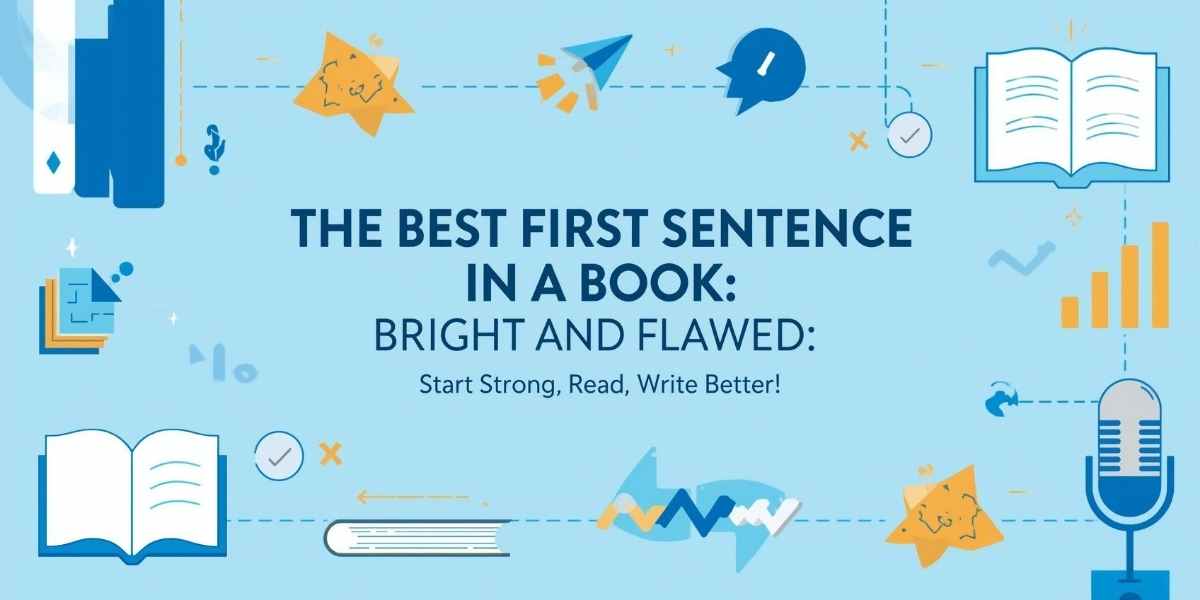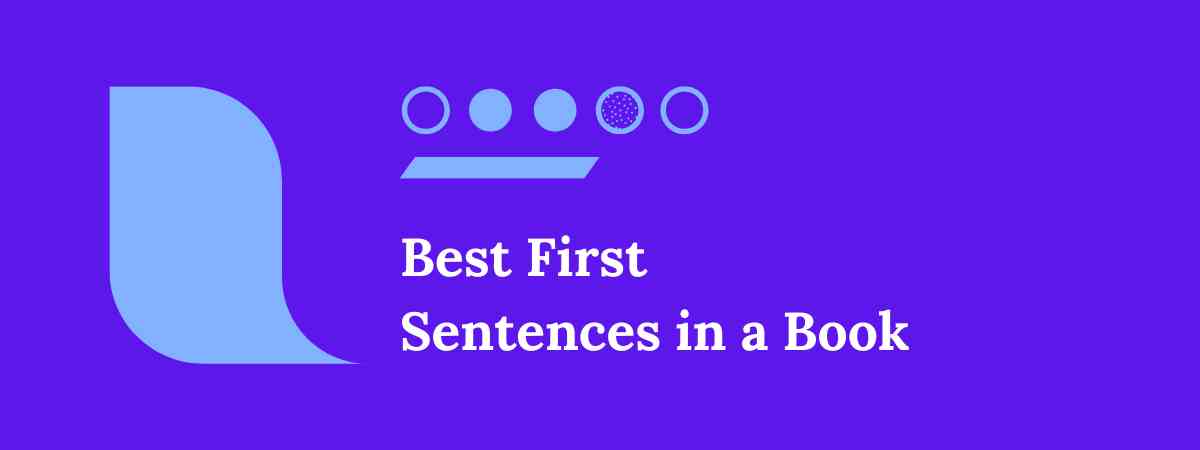The best first sentence in a book has the power to grab attention, set the mood, and create curiosity in the reader’s mind. For English learners and teachers, studying these opening lines is more than just appreciating literature. It is a way to understand how words can shape emotions, introduce characters, and prepare readers for a journey.
The best first sentence in a book is not just a collection of words. It is an invitation to keep reading. A strong opening draws the reader closer to the story and creates expectations about what will follow.
In this blog, we will explore ten examples of the best first sentences in a book, analyzing why they are effective, what makes them memorable, and even where they show flaws. Along the way, you will also see how studying opening lines can improve your own writing skills, whether you are preparing essays, creative stories, or academic papers.
Why the Best First Sentence in a Book Matters
The best first sentence in a book does more than start a story. It sets the tone, creates curiosity, and makes readers continue. Many memorable lines succeed because they catch attention, give direction, and build a strong voice.
For English learners, studying the best first sentence in a book is a way to learn vocabulary, grammar, and rhythm. Teachers also use these examples to show how short sentences create impact and longer ones set the mood, helping students apply these lessons in essays and stories.
The Emotional Impact
The best first sentence in a book can create emotions instantly. Fear, surprise, excitement, or curiosity – these reactions may come from just a single line. Some iconic book introductions throw readers directly into the action, while others slowly prepare the stage. Both methods can be effective when written well.
The Educational Value
The best first sentence in a book is also a treasure for grammar learners. By studying structure, word choice, and punctuation, students improve their writing. Teachers often ask learners to rewrite famous lines in their own words, turning grammar practice into a creative exercise.
10 Examples of the Best First Sentence in a Book
Here we explore ten examples of the best first sentence in a book that have been celebrated, debated, or even criticized. Each one is unique, showing how a simple sentence can shape an entire story.
1. Pride and Prejudice by Jane Austen
It is a truth universally acknowledged that a single man in possession of a good fortune must be in want of a wife.
This sentence is often cited as the best first sentence in a book because it combines humor, irony, and social commentary in one line. For English learners, it is also a chance to study formal sentence construction and word order. It works as both a strong story starter and a statement of theme.
2. A Tale of Two Cities by Charles Dickens
It was the best of times, it was the worst of times,
This is one of the most iconic examples of the best first sentence in a book. The contrast between positive and negative feelings creates rhythm and balance. For learners, it shows how parallel structures in grammar can be powerful. The sentence is long but memorable, demonstrating how repetition keeps a reader engaged.
3. 1984 by George Orwell
It was a bright, cold day in April, and the clocks were striking thirteen.
This line immediately creates confusion and curiosity. The phrase “striking thirteen” tells readers that something unusual is happening. For learners, it demonstrates how a simple change in expected numbers or words can shock readers. Many consider this the best first sentence in a book for dystopian writing.
4. Moby-Dick by Herman Melville
Call me Ishmael.
Short, clear, and effective, this is one of the most memorable examples of the best first sentences in a book. It shows how less can be more. Learners can use it as a model for creating effective book hooks in essays and stories.
5. The Catcher in the Rye by J.D. Salinger
If you really want to hear about it, the first thing you’ll probably want to know is where I was born, and what my lousy childhood was like.
This opening creates voice and personality immediately. Readers can feel the character’s attitude and style. It is a strong story starter because it connects directly with the reader. For English learners, this line is useful for studying conversational tone in writing.
6. The Hobbit by J.R.R. Tolkien
In a hole in the ground, there lived a hobbit.
This is a simple yet effective example of the best first sentence in a book. It introduces a new creature and world in just one line. Learners can see how Tolkien uses plain words to create fantasy, and teachers often use it to show how imagination can start from a short descriptive sentence.
7. The Metamorphosis by Franz Kafka
As Gregor Samosa awoke one morning from uneasy dreams, he found himself transformed in his bed into a gigantic insect. This is a striking example of the best first sentence in a book, showing how a single line can immediately shock and engage readers.
This is unforgettable because it introduces a shocking event immediately. The sentence is long but carefully structured, and it forces readers to continue. For learners, it is a study in how surreal ideas can be presented in ordinary language.
8. The Old Man and the Sea by Ernest Hemingway
He was an old man who fished alone in a skiff in the Gulf Stream, and he had gone eighty-four days now without taking a fish.
This calm, simple, and descriptive line is a great example of the best first sentence in a book. Hemingway’s style uses short, direct words, showing students how plain vocabulary can create powerful novel beginnings.
9. Anna Karenina by Leo Tolstoy
All happy families are alike; each unhappy family is unhappy in its own way.
This line makes a statement that prepares readers for the theme of the novel. It shows how a general truth can be expressed in an artistic way. Learners studying classic literary openings can use this sentence to explore comparisons and contrasts in grammar.
10. Fahrenheit 451 by Ray Bradbury
It was a pleasure to burn.
Short, dramatic, and unexpected, this is a powerful example of the best first sentence in a book. For learners, it shows how emotional words can shock readers and set the stage for deeper themes.
What Makes the Best First Sentence in a Book Brilliant or Flawed
Studying the best first sentence in a book teaches us that not all opening lines are created equal. Some shine because they are bold and unforgettable, while others are criticized because they confuse readers or feel too heavy. Let’s explore both sides.
Strengths of Brilliant First Sentences
- Immediate Curiosity: A line like “It was a pleasure to burn” from Fahrenheit 451 makes readers ask questions instantly.
- Memorable Rhythm: Sentences with repetition or balance, such as “It was the best of times, it was the worst of times,” remain in memory for years.
- Clear Voice: Some great book openers, like Salinger’s in The Catcher in the Rye, show character and personality at once.
- Compact Power: Short introductions such as “Call me Ishmael” prove that simplicity can be stronger than complexity.
Flaws in Some First Sentences
- Too Long or Complicated: Some lines overwhelm new readers with heavy vocabulary. While classic literary openings can be rich, they may feel difficult for beginners.
- Lack of Hook: A weak opener may give information without creating interest. Readers often stop reading if the first line does not connect with them.
- Unclear Tone: If a sentence does not set the right mood, readers may feel lost. Effective book hooks must give direction and style from the start.
By analyzing both strengths and flaws, English learners can see that even great writers faced challenges in creating unforgettable first lines.
How English Learners Can Use These Examples
For students, the best first sentence in a book is more than just an inspiring idea. It is also a practical tool. Here are some ways you can use these lines in your learning journey.
1. Grammar Practice
Take a famous line, such as Austen’s It is a truth universally acknowledged, and break it into subject, verb, and object. This is a useful exercise for learners studying the best first sentence in a book, helping them see how sentence structure creates flow. Teachers often ask students to rewrite the line in different tenses or forms to improve grammar flexibility.
2. Vocabulary Building
Memorable first sentences often use strong and unusual words.
For example:
Kafka’s “uneasy dreams” or Orwell’s “striking thirteen”
introduce vocabulary that sparks interest. Learners can make word lists from these lines and practice them in their own sentences.
3. Writing Exercises
Students can try writing their own strong story starters after studying these examples. A simple exercise is to take one opening line from the best first sentence in a book and change the subject or setting while keeping the same structure. This encourages creativity and helps practice correct grammar.
4. Reading Comprehension
Teachers can ask learners to predict what the story might be about after reading only the first line. This strengthens imagination, critical thinking, and reading skills.
Tips for Writing Your Own Best First Sentence in a Book
If you are writing essays, short stories, or even practice paragraphs, the first line is your chance to make a strong impression. Here are some practical tips to create effective book hooks.
Tip 1: Start with Action
Readers love to feel movement from the very first word.
Example:
- The door slammed shut before she could escape.
Tip 2: Ask a Question
Questions make readers curious and push them to find answers.
Example:
- What would you do if tomorrow never came?
Tip 3: Use Contrast
Opposites create rhythm and surprise. Dickens used this method brilliantly.
Example:
- He was both my enemy and my best friend.
Tip 4: Introduce a Character Quickly
Even a simple description can make readers feel connected.
Example:
- Lena was the kind of girl who never looked back.
Tip 5: Shock the Reader
Surprising words or situations stay in memory.
Example:
- By sunrise, he had already buried three secrets in the garden.
By practicing these techniques, learners can write strong story starters and unforgettable first lines in their own work.
Why Teachers Should Use First Sentences in Lessons
For teachers, the best first sentence in a book is a powerful teaching tool. It combines grammar, creativity, and literature in one activity.
Grammar Lessons
Teachers can highlight verb tense, punctuation, and sentence structure using memorable first sentences. For example, Dickens’ line from A Tale of Two Cities is excellent for teaching parallel structures.
Writing Inspiration
When students struggle to start an essay, giving them examples of great book openers provides models to follow. Teachers can even ask them to imitate famous styles before writing their own.
Literature Appreciation
Discussing iconic book introductions helps students connect with world literature. Even if they cannot read the full novel, analyzing one line brings them closer to famous works.
How to Apply These Lessons to Essay Writing
The skill of writing the best first sentence in a book can be applied to essay introductions as well. Just like novels, essays need a strong hook to capture attention.
- Use a surprising fact or statistic in place of a dramatic opening.
- Start with a bold statement that sets the tone.
- Ask a thought-provoking question to engage readers.
By using techniques from powerful novel beginnings, students can make their academic writing more engaging.
The Psychology Behind the Best First Sentence in a Book
To understand why certain lines work, it helps to think about psychology. A reader’s brain reacts strongly to surprise, contrast, and rhythm.
- Surprise: When something unusual appears, like Orwell’s clocks striking thirteen, our brains want an explanation.
- Contrast: When two opposite ideas are placed together, like Dickens’ best and worst of times, our brains enjoy the balance.
- Rhythm: Sentences with flow or repetition are easier to remember, making them memorable first sentences that stay with us.
For teachers, this psychology can be explained in simple classroom discussions. Students can practice writing their own lines using one of these psychological effects.
Practical Classroom Activities
Teachers looking to use the best first sentence in a book in lessons can try these activities:
Activity 1: Sentence Imitation
Give students five famous opening lines. Ask them to copy the structure but replace the words with their own ideas. For example:
- Original: In a hole in the ground, there lived a hobbit.
- Student version: In a small town by the river, there lived a quiet boy.
This builds confidence and shows how great book openers can be adapted to new contexts.
Activity 2: Guess the Story
Read only the first line of a novel to the class. Then ask students to predict the genre, theme, or possible story. This activity works well because it connects reading comprehension with imagination.
Activity 3: Rewrite for Tone
Take one unforgettable first line and rewrite it in three tones: funny, scary, and formal. This exercise is useful for learners studying the best first sentence in a book, showing how tone can completely change a story starter.
Writing Practice for Students
For learners working alone, here are some tips to create effective book hooks:
- Start with a bold statement: The village had never seen rain until that morning.
- Use sensory details: The smell of burnt bread floated through the empty street.
- Introduce conflict immediately: She had ten minutes to decide whether to run or confess.
- Experiment with length: Try writing both a very short and a long descriptive opening. Compare which one feels stronger.
These methods make writing practice more enjoyable and creative.
Common Mistakes to Avoid
Not every attempt at writing the best first sentence in a book succeeds. Learners should watch out for these common mistakes:
- Too much description: A sentence overloaded with adjectives can feel heavy.
- Clichés: Overused phrases like ‘It was a dark and stormy night’ no longer attract attention.
- Unclear subject: Readers should immediately know who or what the line is about.
- Grammar errors: Mistakes in the opening line reduce its impact.
Teachers can guide students to edit their work carefully and avoid these traps.
Examples of Student-Friendly First Sentences
Here are some examples that English learners can use as models or inspiration:
- Every window in the city opened at once.
- The letter arrived on a Tuesday, but no one dared to open it.
- Silence filled the classroom until the clock struck seven.
- By the time the sun rose, the village had vanished.
These are simple, clear, and effective book hooks that can be adapted to essays, stories, or creative writing assignments.
The Role of First Sentences in Essays and Reports
While novels aim to entertain, essays and academic writing also benefit from strong introductions. The best first sentence in a book teaches us that readers pay attention from the very first line, no matter the format.
In Essays
A strong opener could be a question, a surprising fact, or a bold claim.
For example:
- Why do so many students fear grammar when it is actually the key to better writing?
In Reports
Even reports can benefit from a clear, engaging first sentence:
- This study shows that consistent practice improves vocabulary retention by 40 percent.
By applying lessons from powerful novel beginnings, students can improve the quality of their academic work.
Conclusion
The best first sentence in a book is more than a line of text. It is a gateway to imagination, a key to grammar practice, and an inspiration for writing. By studying brilliant and flawed examples, learners discover what makes an opening line unforgettable. Teachers can use these sentences to build lessons, while students can apply the techniques to essays, stories, and creative exercises.
Whether it is the humor of Jane Austen, the rhythm of Charles Dickens, or the simplicity of Herman Melville, every example offers a lesson. Remember that strong story starters can be short or long, simple or complex, but they must always make readers want more.
If you are learning English or guiding others, practice creating your own unforgettable first lines. One day, your sentence could become the next iconic example of the best first sentence in a book, remembered by future readers.



